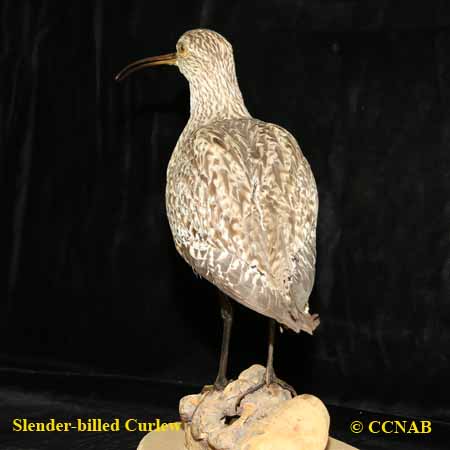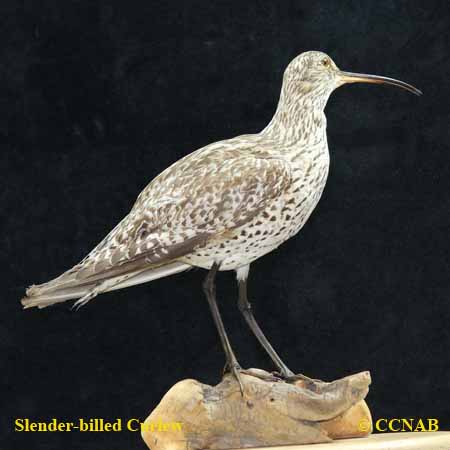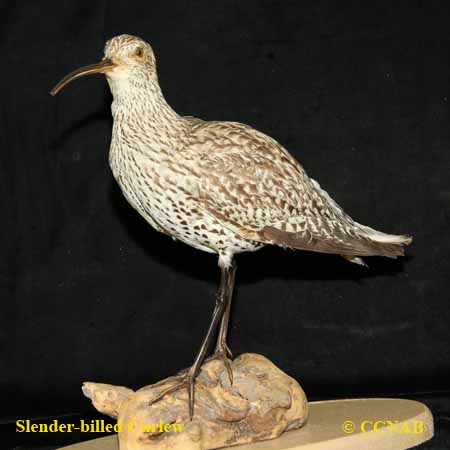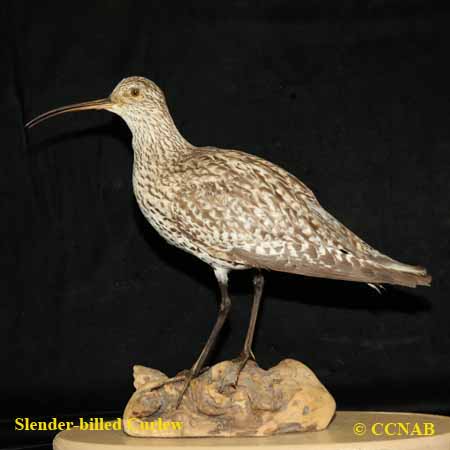North American Bird Search Box
This search box can be used to find bird species using bird's english, french or latin name, or to identify bird by its 4 letter Alpha Code
Field Guide for all the Birds of North America
Slender-billed Curlew
4 Letter (english names) Alpha Code: SBCU (5)
Courlis à bec grêle
Numenius tenuirostris
Information, images and range maps on over 1,000 birds of North America, including sub-species, vagrants, introduced birds and possibilities
Book Tile: Birds of the Nigara Frontier Region
Authors: Beardslee and Mitchell
SLENDER-BILLED CURLEW
Numenius tenuirostris Vieillot.(note 1)
Accidental very rare V.
A mounted specimen of a Slender-billed Curlew (Numenius tenuirostris) is in the Buffalo Museum of Science (BSNS 2092), obtained with the collection of Dr. I.L. Terry of Buffalo.
There was no tag attached to the specimen,(note 2) but Dr. Terry's son, Dr. I.L. Terry Jr., told us that his father had shot the bird at Crescent Beach, Ontario, many years ago. He also referred us to his friend, Mr. W.R. Harris of Annandale, Virginia, who is the son of the hunter companion of Dr. Terry's father. In a letter dated September 19,1962, Mr. Harris stated: "With reference to your European Curlew, this bird was shot by Dr. I.L. Terry, about 1925 at Crescent Beach, Ontario, Canada. The exact locale was on the east side of the point in the western end of Crescent Beach Bay. The area there is marshy and used to be frequented by many snipe, plover and so forth. This bird was mounted by the man who was then associated with the Buffalo Museum of Science and his name was Mr.Santens (I am uncertain of the spelling of this name, but I do remember that this man was of Belgian extraction). The time of hear, I should mention, was to the best of my recollection, in the fall, probably in October or early November." In a later letter dated August 8, 1963, Mr. Harris gave us this added information: "I was not with Dr. Terry at the time he shot the Curlew in the field. I was at the house when he and my father, who is now deceased, returned with the bird. I remember that there was considerable discussion about it and as I recall, the positive identification of the species was made by Mr. Santens.(note 3) I know that Mr. Santens mounted the bird, for I saw it many times at Dr. Terry's home... The reason the bird was mounted was because it was an unusual species and Mr. Santens was interested in helping Dr. Terry develop a bird collection." This was the only specimen of a European bird in Dr. Terry's collection.
Measurements of this mounted specimen are given in the first column, and figures for ten males of this species taken from Witherby et al.(note 4) are listed in the second column, as follows:
Exposed culmen 76 mm. 67-75 mm. (bill from feathers)
Tarsus 62 mm. 57-65 mm.
Wing (worn) 241 mm. 245-256 mm.
Tail 96 mm. 91-102 mm.
1. According to Peters, J.L., "Check-list of Birds of the World,"2:261.
2. Dr.Terry originally had a tag on all his specimens, but after being warned by a friend that some of the specimens might have been taken illegally because of new laws covering the taking or possession of migratory birds without a permit, he removed all the tags from the specimens.
3. Apparently Santens originally identified the specimen as a European [=Eurasian] Curlew (Numenius arquata) when it was brought to him for mounting, possibly not having a description or measurements available of the Slender-billed Curlew (N. tenuirostris), which it resembles superficially. He knew, however, that it was an exptoc species, unlike any of our native curlews.
4. Witherby, H.F., et al., "The Handbook of British Birds," 4:180.
5. Ibid., p. 179
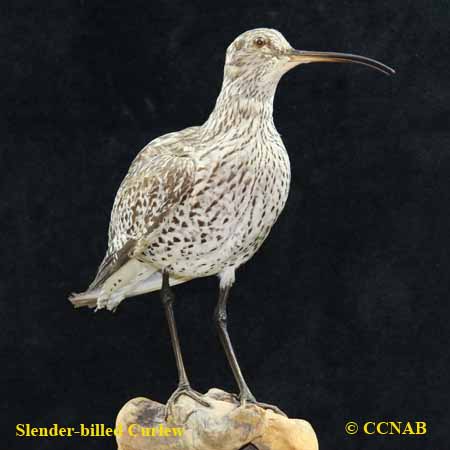
Images are courtesy of the Buffalo Museum of Science in Buffalo, New York, USA.
Life, Habitat and Pictures of North American Curlews
| B L | W W | W | Family | Latin Name |
|---|---|---|---|---|
| 16" 40.6cm | 31" 78.7cm | 11 oz 311.8g | Scolopacidae | Numenius tenuirostris |
- Summer
- Year Around
- Winter
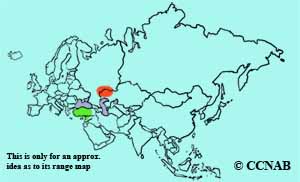
The photograph shows some of the heart-shaped spots on the breast which helped to identify this species. The Slender-billed Curlew breeds in the steppes of western Asia, northern Kazakhstan and western Siberia. It winters in Iraq, the eastern Mediterranean area and northwestern Africa. A straggler in western Europe,(note 5) it is a relatively rare bird in its normal range and some ornithologists believe that it may be on its way to extinction.
Reference to Other Bird Site:
ABA - American Birding Association This site represents an organization that maintains official records of all birds species that have been proven to have been seen inside the perimeters of the North American Continent and the surrounding bodies of water. Regular revised versions are posted to keep the bird list current at all times. This is the list used by all serious birders over their lifetime. You may be aware of the movie called the "Big Year". It was with this list that all the competing birders used in an attempt to set a new record as to how many bird species that could be seen by an individual birder in one calendar year.
